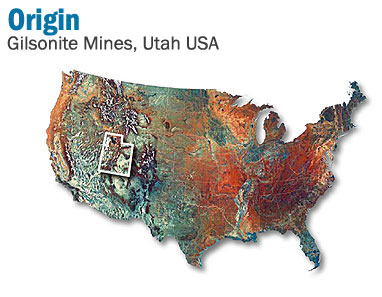GILSONITE is a pure hydrocarbon, with a melting point of 165°C, found in this form only in the Uintah Basin of eastern Utah. The mineral is a natural bitumen and geologically a petroleum based solid and therefore extremely compatible with petroleum bitumen. When blended, a very intimate molecule of GILSONITE and bitumen is formed, one that takes on some hardness and durability of GILSONITE while still retaining the flexibility of the Bitumen.
ALL ABOUT GILSONITE
ORIGINAL GILSONITE – ONLY FROM THE UINTAH BASIN IN UTAH (USA)
GILSONITE is found below the earth’s surface in vertical veins or seams that are generally between two and six feet in width, but can be as wide as 28 feet. The veins are nearly parallel to each other and are oriented in a northwest to southeast direction. They extend many miles in length and as deep as 1500 feet. The vein will show up on the surface as a thin outcropping and gradually widen as it goes deeper. Due to the narrow mining face, GILSONITE is mined today, much like it was 50 or 100 years ago. The primary difference is that modern miners use pneumatic chipping hammers and mechanical hoists.
GILSONITE is included in a class of solid bitumens known as asphaltites. GILSONITE deposits are located in eastern Utah in the United States. They are different from other asphaltites because of their:
- high asphaltene content
- high solubility in organic solvents
- high purity and consistent properties
- high molecular weight
- high nitrogen Content





 Deutsch
Deutsch English
English